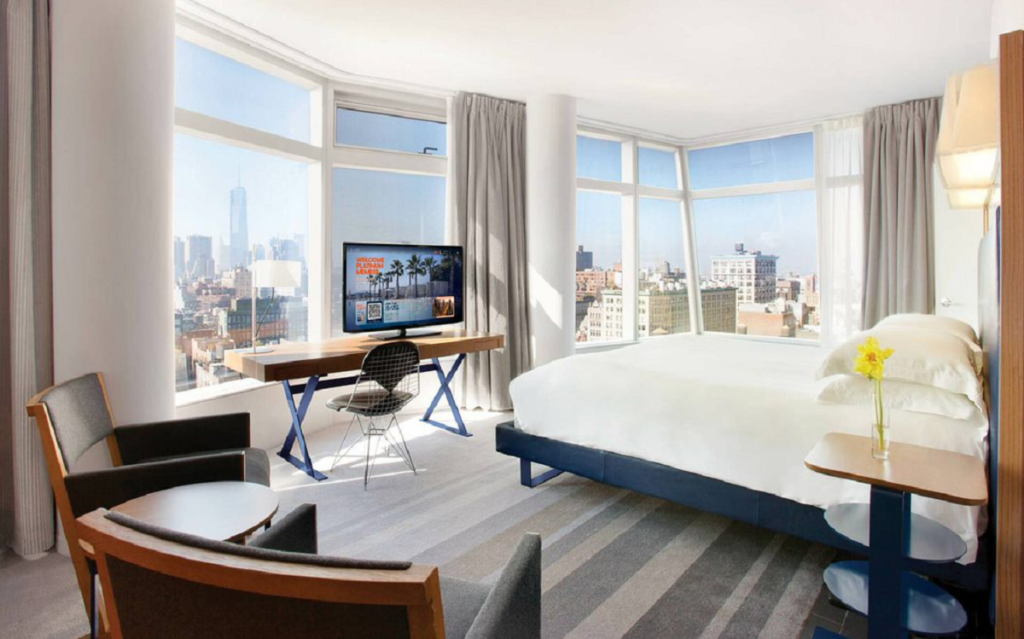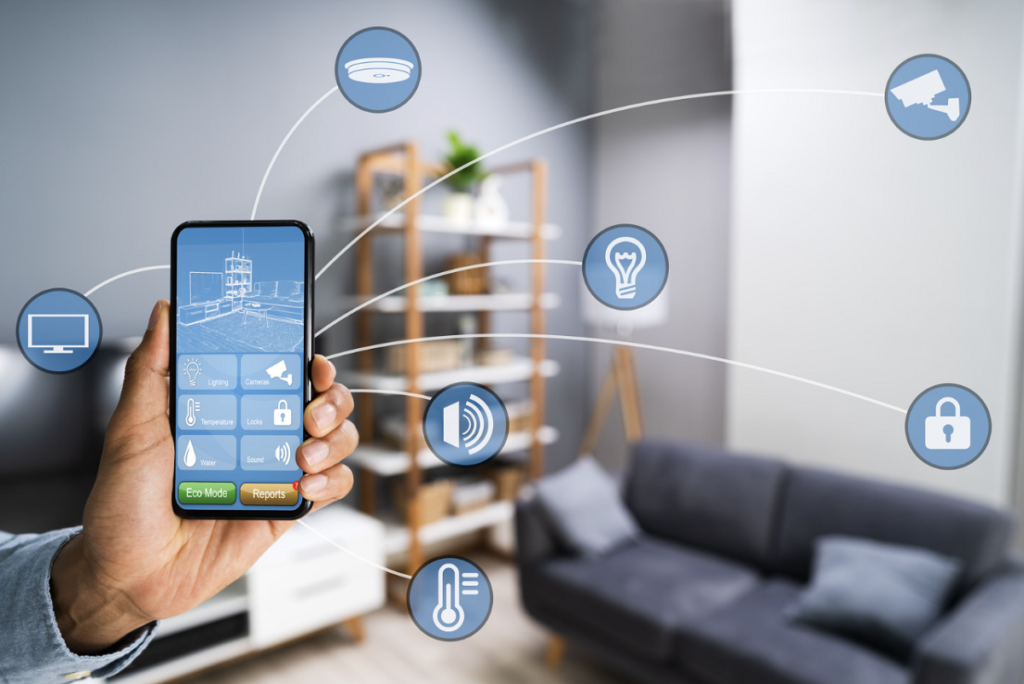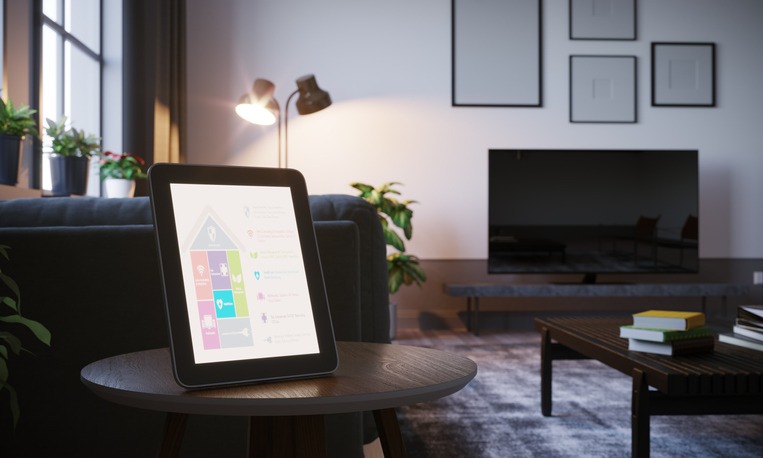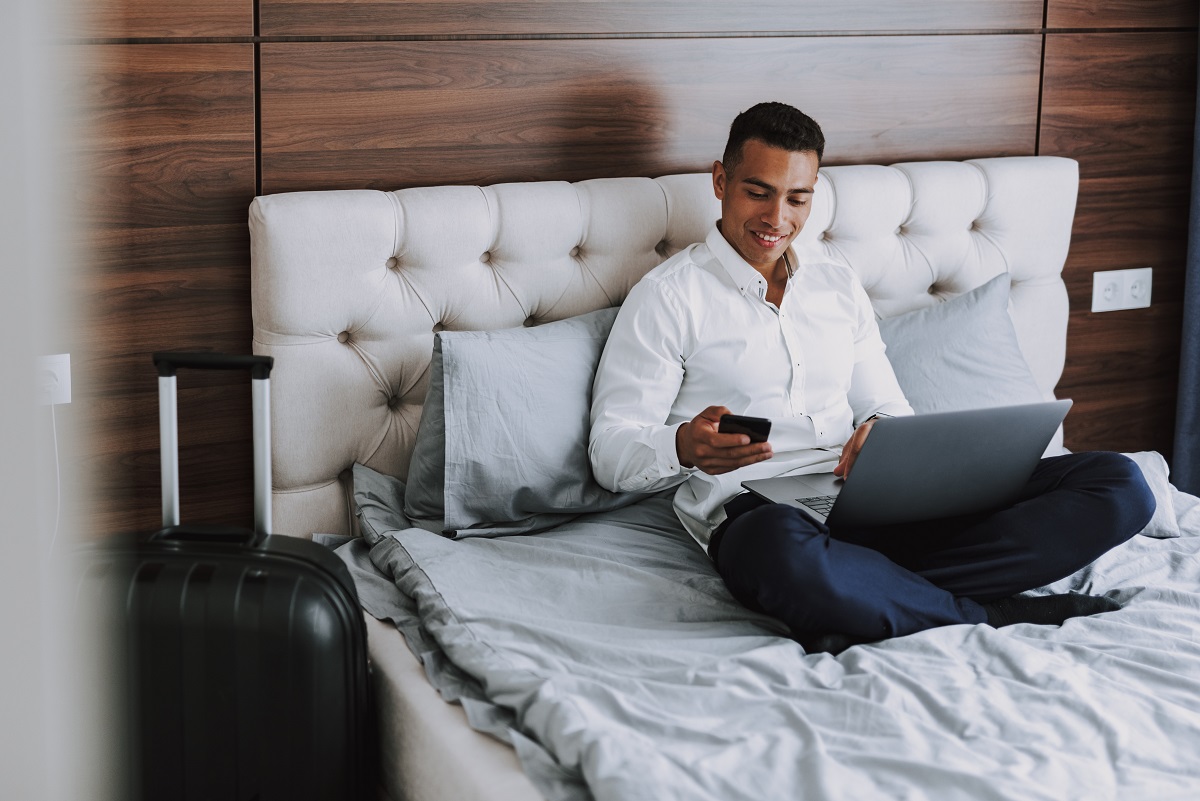And which in-room technology you might want to skip…
- In-Room Technology: A Must-Have for a Great Guest Experience
- First, the basics
- Smart TVs and In-Room Entertainment
- Smart Rooms
- Voice-Activated Devices
- Apps, Tablets, and Digital Assistants
- Some in-room technology will capture attention, but that’s not always a good thing
- What should you watch out for when choosing in-room technology?
- Conclusion
- Here are some helpful links to learn more
In-Room Technology: A Must-Have for a Great Guest Experience
Modern hotels are incorporating technology at an ever-faster rate, enabling greater personalization, automation, efficiency, and sustainability. Guests are coming to expect some technologies as “must-haves,” while others will set your property apart from your competitors. In general, though, it’s not a matter of whether to spend on technology for a better guest experience, but which technologies will make the biggest impact.
We have discussed elsewhere some of the key technology solutions that hotels should be investing in for overall property technology. Here, we’ll focus on in-room technology that will support a better guest experience, along with some solutions that may not be right for everyone, and we’ll also consider some aspects that you’ll want to watch out for as you implement new technology solutions.
First, the basics
Some items are expected amenities in every hotel, such as Internet, phones, and TVs. But just because everyone has them doesn’t mean you can’t use them to differentiate your property. A so-so solution here will still be noticed by your guests and may result in lower ratings and fewer repeat guests.
The most crucial of these items is your digital infrastructure, which plays a vital role in almost every part of a property’s operations. Options to consider here include fiber, copper cabling, and wireless backhaul; read our article “Digital Infrastructure: The Foundation for Better Guest & Resident Experiences” to learn more. If you don’t have the right infrastructure to support the technology solutions your property uses, then the solutions themselves won’t make much of a difference (or will actually affect your ratings negatively) because their performance will be poor.
One key example of this is your guest WiFi. It seems like such a basic amenity – nearly every property offers this, and guests expect it just like they expect heat, AC, and hot water – in fact, for most people today, it’s just as important, and it’s still the #1 amenity that guests demand.
But simply offering WiFi for guests isn’t good enough. You need to be sure that your guests can easily connect to your WiFi and that it’s fast, reliable, and high-performing even when your hotel is fully booked and everyone is using it. Poor performance will lead to low ratings and may even cause your guests to leave and book elsewhere. This may seem obvious, but many guests still complain that hotels aren’t meeting this standard.
With the addition of newer in-room technology to your hotel, you need to make sure that you’ve got enough bandwidth to handle the additional traffic and that you’re implementing bandwidth management to ensure good performance.
A modern VoIP phone system is also necessary. Even though many guests may not rely on in-room phones, they’re still crucial for communication that meets federal regulations for things like 911. The best systems will also enhance your guest experience with PMS-linked features such as personalized messaging, touchless checkout, and access to guest services.
Another item that many don’t consider is outlets. Guests typically bring multiple devices with them, and they frequently complain that there aren’t enough outlets (including outlets that fit larger adapters) throughout the guest room. In addition, guests tend to get annoyed when the only outlets available are installed behind furniture or in other hard-to-access areas – so outlets need to be easy to reach.
USB charging ports can be tricky. While many guests do request these, federal agencies have warned of the dangers of public USB charging stations (including in hotels), which can be used to install malware and monitoring software on users’ devices. There’s some debate as to whether this is more than just theoretical, and guests continue to request USB ports, so you may want to make some available.

Smart TVs and In-Room Entertainment
Although in-room flat-screen HDTVs are now considered a basic item, the expectations for what’s offered are changing. To support the functionality guests now demand, hospitality-grade smart TVs are essential. Smart TVs will offer additional content options and guest information solutions. Hospitality-grade TVs in particular include encryption technology (Pro:Idiom and/or LYNK DRM) to enable content to be deployed in multiple rooms without the possibility of illegal duplication, and they’re also built to withstand commercial use. Most major hotel brands have at least begun to roll out smart TVs, but they are not yet ubiquitous, so this is still an opportunity to differentiate your property.
To respond to guests’ demands for touchless service, some hotels now offer virtual remotes allowing guests to control the TV using a web-based (or app-based) remote control on their own devices.
Many of us will remember the days when hotels advertised the availability of premium TV content as a paid add-on, but now it’s crucial to offer free-to-guest (FTG) TV services with local content, premium channels, and even music. But guests are no longer satisfied with only whatever’s available via live or on-demand services; they’re looking for a home-like experience that enables them to view their own content, and nearly half of guests now say that technology enabling them to connect to their own accounts for content is a must-have.
Some hotels have installed smart TVs with over-the-top or OTT services for streaming that allow guests to access their favorite shows. However, there are some difficulties that come with this approach. It isn’t always easy to sign in on the guest room TV (remembering login credentials and typing them in), and it’s not necessarily secure, especially since someone needs to clear out guest credentials at the end of a stay. Ensuring that this is done for each TV in each room for every guest is a lot of work!
Another option is to offer casting, which enables guests to pair their devices wirelessly with the in-room TV so they can watch content from their own apps on a bigger screen. Unlike streaming, casting doesn’t require guests to log into the TV – they can control the content from their own device once it’s paired with the TV.
The trickiest thing here is to make the connection process simple and obvious – guests don’t want to have to guess how to connect or go through a tedious process. One option is to use a QR code on the TV screen to help guests pair their devices with that TV (and only that TV, so there’s no security risk). Another option is to tie this functionality to the PMS and the WiFi, so that, as soon as a guest connects to the WiFi, it automatically authenticates their device to the TV(s) in their room.
Although you can easily enable these options with hospitality-grade smart TVs, they can also work with Chromecast devices added to non-smart TVs.
Hotels can offer an even better guest experience by using IPTV-enabled interactive entertainment portals. These solutions not only tie together options for FTG content, streaming apps, and casting options with a single easy-to-use interface, but they also offer additional services – for example, viewing weather, airport info, and restaurant menus, ordering room service or concierge services, retrieving front desk messages and event announcements, sending service requests, booking spa services, checking out, and much more. Such portals can connect with the hotel’s PMS to deliver a personalized experience for the guest. With more guests demanding self-service options and greater personalization, this is an easy way to offer services to increase guest satisfaction while also generating revenue for the hotel.
A less-frequently implemented option, but one that’s growing in importance (especially for higher-end hotels), is gaming. In line with other guest expectations for a home-like experience, more guests are saying that they’d like to access not only their own viewing content but also other entertainment options such as gaming – both for adult gamers and for families with children. As a differentiator, some hotels have chosen to offer a small number of premium rooms dedicated to gamers, with all the equipment they’ll need, while others have added options for borrowing game consoles with pre-loaded games.

Smart Rooms
One solution you can implement even before guests enter their rooms is mobile room keys, which offer touchless functionality, allow for remote configuration and management, reduce operating costs, and improve the security of your entire property. There are several available options for this technology, including NFC, RFID, and Bluetooth. The use of mobile room keys has risen rapidly since the COVID-19 pandemic began, with an increase second only to contactless check-in, and hotels can easily combine the two technologies for an improved guest experience. However, you’ll need to be sure you have a backup option, for example, if a guest’s phone dies and they can’t use it to enter their room.
Additional smart technology that uses connected sensors and actuators to take measurements and control equipment is changing the guest experience rapidly, offering personalization and convenience that simply wasn’t possible previously. You can link in-room smart devices to mobile apps, voice-enabled devices, and even the hotel’s PMS to improve your hotel’s carbon footprint while providing a more home-like experience. And guests have become used to smart home devices, increasing the demand for such technology in hotels.
For instance, personalization of settings for climate control, lighting, audio, and more can improve the in-room experience by making guests feel more at home, and surveys show that guests are increasingly asking for these features. You can save information across visits to have settings ready for them, or you can enable the use of mobile phone apps or in-room kiosks or tablets for control of settings including lighting, room temperature, curtains/shades, and more. At least 25% of guests in recent surveys mention auto-adjustment of room settings based on pre-shared preferences (such as through a post-booking survey or using data saved from previous visits) as something they’d like to see in hotels.
Operational monitoring and automation solutions use items such as smart thermostats and smart lighting to improve energy management and sustainability by adjusting settings based on whether a space is in use, while maintenance and logistics solutions offer ways to use systems more efficiently, spot problems that need to be fixed, and enable staff to respond more quickly to guest needs. For example, preventive maintenance solutions detect issues before guests complain; smart solutions are available that monitor for problems such as air quality issues and water leaks. (A single leaky toilet can cost over $800 per year, not including the cost of water damage – so this can save money as well as prevent headaches!)
Voice-Activated Devices
Many guests are already using voice-activated devices in their homes, cars, and offices, so it’s becoming more widely expected that hotels offer this technology as well. Voice-activated devices allow guests to order room service, schedule appointments, access concierge services, adjust lighting, temperature, curtains, and door locks, control TV and entertainment options, and more.
There are some potential downsides to consider with this technology. While an increasing number of guests are seeking this option and over half of hoteliers say they see potential in including it, there has been a negative reaction to some pilot projects. For example, a major hotel chain tried offering Echo devices in guest rooms for service requests, but many guests simply disconnected the devices, likely due to privacy concerns. Not many used them, and they didn’t result in increased satisfaction scores.
However, since the pandemic, far more guests are requesting touchless technology, so their views on voice-activated devices may have changed; in fact, in some recent surveys, nearly half of guests said they’d like to use voice-activated controls for their in-room amenities. It’s important to survey your guests to see whether this is something they’d value, and if so, you’ll want to consider how to ease any privacy concerns.

Apps, Tablets, and Digital Assistants
While mobile apps can enable guests to order service and control in-room settings on their own devices during their stay, many guests say they don’t want to download yet another app. If you’re considering implementing an app, you’ll want to make sure that it offers enough value to the guest to overcome this reluctance – for example, by using the same app for mobile check-in, in-room controls, service requests, and more, especially if you can tie it into your PMS for greater personalization and easier logins. The more frictionless and automated it is, the more likely your guests will be to download your app.
Another in-room technology that guests are starting to expect is tablets in guest rooms. Hotels are starting to offer these so guests can control in-room devices, order room service, request housekeeping, and more.
Some hotels have gone a step further and replaced the in-room phones with a combination device that serves as a phone and a tablet-style digital assistant and offers both touchscreen and voice-activated interfaces. Guests can use these devices to control in-room settings for things like lighting, temperature, and TV, and these devices can also act as a digital concierge to order services and request information.
Some in-room technology will capture attention, but that’s not always a good thing
Hotels have begun adding lots of flashy new in-room technology to attract guests, such as TVs embedded in mirrors, smart mirrors, digital glass, and interactive walls – even electro-responsive fibers in bedding and pillows! And for some properties, especially luxury hotels and resorts, these technologies may make sense. For example, some hotels have installed fully interactive smart mirrors that not only can double as a TV, but also enable guests to order services, view information such as weather, news, and maps, and even receive recommendations for things to do. While these devices are expensive, guests say they appreciate them and use them often, and they’ve become a revenue generator by enabling the hotel to promote add-on services to guests.
However, not only are some of these technologies quite expensive, making them suitable only for elite properties, guests don’t always value them – and some have been very publicly critical of bad experiences. Major newspapers have published articles from authors fuming about how difficult to use and how intrusive they found some of these high-end technologies, with complaints of everything from not being able to figure out the hidden or overly complicated controls to being bothered by a constant electronic glow from devices and making it even harder to disconnect and relax.
This is not the kind of attention you want! So when deciding whether to add some of these less-common technologies, you’ll want to determine whether they’ll actually add value for your guests and whether they’ll fit into your overall approach. They may be great investments for luxury properties serving tech-savvy guests, but perhaps not so much for properties focused on a high-touch experience for guests with a more traditional bent.
What should you watch out for when choosing in-room technology?
Using in-room technology in the right ways can certainly enhance your guests’ experience, as well as improve your hotel’s efficiency and potentially even generate revenue. However, there are some things to keep in mind when deciding how to implement these solutions. We’ve alluded above to some of the potential pitfalls, but now let’s consider them more specifically.
Security and privacy are always at the top of mind for many guests. While guests may expect modern hotels to incorporate many of these new technologies, many guests will also be wary of poor security and potential intrusions of privacy. You’ll want to consider how to improve both security and privacy when implementing in-room technology, and you’ll want to reassure guests by raising their awareness of what actions you’ve taken to that end.
Performance is also important. It won’t help if you offer a particular technology but it performs poorly. This is partly why you need to make sure your digital infrastructure can handle the additional traffic generated by these solutions.
You’ll also want to consider guest perceptions of these technologies. As noted previously, which in-room technologies will be most valued by guests may differ from one property to another. Guest surveys can be useful here, so it’s not surprising that many hoteliers say they’re planning to use (or continue to use) these to determine how best to serve their guests’ needs and expectations for technology. While it’s safe to assume that guests will want fast, reliable WiFi and a variety of in-room entertainment options, consider surveying your guests to determine whether they’re interested in additional technologies such as voice-controlled devices or interactive smart mirrors.
Consider ease of use to make sure you’re choosing a solution that will be intuitive for guests, not requiring extra steps or guessing to figure out how to do things or which switch to use. Friction = frustration, and that will lead to poor satisfaction ratings, bad reviews, and fewer return visits. Similarly, you’ll need to consider the needs of your less technically-savvy guests and offer alternatives and assistance so they won’t feel frustrated and annoyed. Be sure that everything they could easily do before is still easy to do with the new solution and that you communicate with your guests so they understand what you’re offering and how to use it.
You’ll want to be sure there isn’t a single point of failure for your entire technology ecosystem and that you have a backup plan for when something goes wrong (as it inevitably will). And you’ll need to incorporate training for your staff to be sure they know how to handle both the new technology and what to do when they need to handle a situation manually.
Finally, you’ll need to figure out how to balance human touch and technology. Guests may be asking for touchless and self-service options, but that doesn’t mean they don’t appreciate a personal touch sometimes. Even guests who prefer a touchless/self-service experience also say they’d like the occasional personal greeting or special service. You’ll need to consider this when deciding when to implement technology and when to use a more human approach.

Conclusion
With the right in-room technology and a well-performing digital infrastructure to support it, you’ll be able to offer guests a great experience that will set your hotel apart from your competitors, improve efficiency and sustainability, and even find new opportunities to generate revenue.
Here are some helpful links to learn more
- Guestroom Technology – The Future is Now
- What a Guest Wants, What a Hotel Needs
- Hotel technology: Your property’s complete guide to hotel industry systems and products
- 2022 Lodging Technology Study: Redefining the Guest Experience
- 73% of travelers want hotels with self-service tech
- When technology misses the mark

